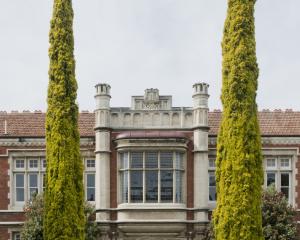

You've got your other-worldly baobabs in Madagascar, the amazingly huge leaves of Brazilian giant rhubarb (Gunnera manicata), century plants (Agave americana) with their towering flower stalks, odd-looking young New Zealand lancewoods and so on.
Tucked in between the Dunedin Energy Centre and the Dunedin Central Fire Station in Castle St is a bizarre little tree with really ferocious-looking leaves. There's another by the Oxford St car park entrance of Hope and Sons opposite KFC. Any film director would be happy to use such plants in shots of an alien planet. It's worth taking a closer look at these particular "aliens" because most people only get a fleeting glance of them as they drive past.
They're bull banksias or giant banksias (Banksia grandis), and they grow naturally in the southwestern corner of Western Australia around Perth. As far as serrated leaves go, if the New Zealand lancewood (Pseudopanax crassifolius) and fierce lancewood (Pseudopanax ferox) are the barracouta of trees in this part of the world, bull banksias are the great white sharks. Each long, stiff leaf is like a double-edged saw with giant teeth, comprising two rows of big pointed triangles on opposite sides of the midrib - a fearsome-looking frond indeed! The grey wrinkly bark and occasional yellow bristling flower cones are interesting enough, but it's the leaves that really set this tree apart.
I've often wondered how things in the natural world might have influenced human inventions and buildings. Aircraft wings are clearly inspired by bird wings. Some submarines apparently owe part of their design to dolphins and porpoises. Perhaps propeller blades and helicopters owe something to winged sycamore seeds and other seeds that swirl and whirl their way to the ground. Could it be that the distinctive upturned corners on old Chinese buildings were modelled on the similarly upturned branches of conifers?
What about saws? People were using them in Egypt a few thousand years ago, a long way from where bull banksias and lancewoods grow. Maybe they were based on rows of fish teeth rather than a plant. I'm not aware of any evidence that indigenous Australians and New Zealand Maori deliberately designed something like a saw to cut wood or bone, though some of the sharp-edged stones they used had wavy edges.
No article on a banksia would be complete without mentioning Joseph Banks (1743-1820), the well-known and well-connected British botanist who joined Captain James Cook on his 1768-71 voyage to Australia, New Zealand and other South Pacific islands.
Among other things, Banks is famous for making the Royal Botanic Gardens at Kew in London the world's leading botanic garden of his time. His long and illustrious career included the discovery (for Europeans anyway) of about 1400 plants and the shipment of about 30,000 plant specimens back to England. It was a hard act for any botanist to follow.
In New Zealand, Banks is best remembered by Banks Peninsula near Christchurch, and by the botanical names of native plants such as Cordyline banksii - ti ngahere or the forest cabbage tree. In Australia, there are about 170 species in the impressive Banksia genus of the Proteaceae family of plants, including the bull banksia.
I don't expect our local bull banksias to grow to their full height of 15m anytime soon, but I hope they continue to be appreciated as one of our charmingly eccentric urban trees.












